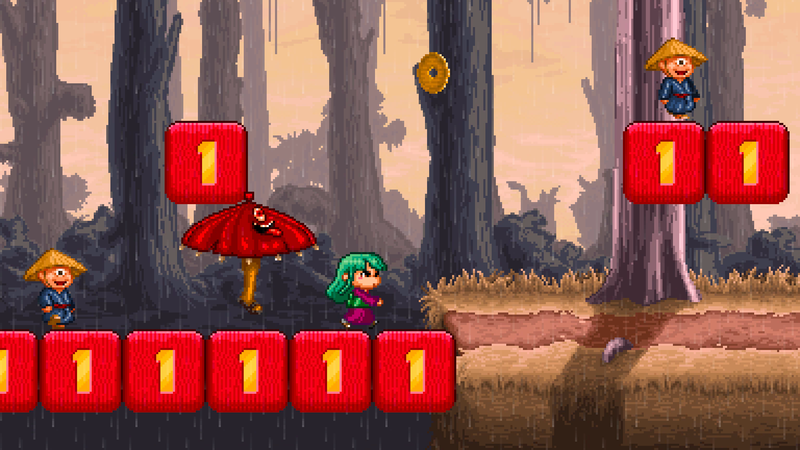Rising Dusk Review
Cash rules everything around me.

Rising Dusk, a retro-style puzzle platformer, is one of those games that feels like it belongs back in the ‘90s with the rest of the SNES catalogue. From the beautiful pixelated visuals to the head-bopping music, Rising Dusk pays tribute to the era through-and-through.
This comes at a cost, however; even Rising Dusk’s design sensibilities feel dated and often frustrate more than they entertain. Puzzles tend to come down more to laborious trial-and-error than anything else. Sure, you’d be hard-pressed to say Rising Dusk stands in rank with those SNES classics, but it would almost certainly be considered a cult classic – a hidden gem that just needs a bit more polishing to be truly great.
In Rising Dusk you play as Tamako, a young girl who has seemingly been transported into a fantastical world full of Yokai – the ghosts and demons oft-mentioned in ancient Japanese folktales. It’s worth noting that Rising Dusk’s world really steals the show with its gorgeously detailed pixel art and charming characters. It almost has the look of the chunky, colourful sprites of The Legend of the Mystical Ninja and Bonk’s Adventure. The one thing that kept me going through Rising Dusk was getting to see what the next level would look like, with each stage playing host to a variety of colourful locales such as hot springs, rice fields and bamboo forests that are a joy to explore.

Mechanically, Rising Dusk does play a little different to your typical SNES platformer – given that the levels regularly task you with trying to avoid the coins scattered around the level, rather than collecting them as you would impulsively in a Mario game. Throughout each stage in Rising Dusk are platforms with numbers written on them. If Tamako has collected the same amount of coins during the level as the number on the platform, the platform will disappear if jumped upon. This is bad, as these kinds of platforms can be the only way to access the secrets and collectables peppered throughout each level.
As such, you usually want to avoid all the coins, though certain levels will task you with the opposite as well – collecting as many coins as possible to progress. There are also occasional boss battles which are a real treat visually but gameplay-wise tend to be a cakewalk.
Each level is generally simple to navigate from A to B, and while the puzzles on the straight-and-narrow never gave me too much hassle, each level has tougher puzzles that stray from the beaten path that you’ll have to carefully manage your coin total to complete. In theory, this could lead to engaging puzzles but it ends up being underwhelming in practice.
Many puzzles feel more like trial-and-error exercises than anything else; frequently, I would make it halfway through the level before realizing there was a secret I couldn’t access because I collected too many/too few coins and simply had to start the level over with that in mind. I’d hazard to even call trial-and-error level design like this a puzzle – it’s less about the player using problem-solving and initiative to solve a puzzle and more about the player repeatedly realising they’ve screwed themselves out of a collectable – before being forced to restart the level to get another shot at it.

To make matters worse, there’s something awfully slippery about the way Tamako controls. Movement doesn’t feel as precise as it needs to be for a platformer in which avoiding objects is key to solving puzzles. The cherry on top is that Rising Dusk is extremely fond of the timeless gag of tricking players into running into/jumping into/landing on coins that are placed in very inconvenient, easy-to-get positions. And if you’re going for the collectables, oftentimes it’ll be one stray coin that’ll get you, forcing you to restart again from a checkpoint or from the beginning of the stage.
It’s a rather unfriendly design which feels a bit at odds with the charming, almost Studio Ghibli-esque visual style. Frequently I would exit the game in a huff after finding out I would have to restart the same level for a third or fourth time just to get one stray collectable.
It’s not all bad, though. There are certain stages in Rising Dusk that I appreciated more than the typical trial-and-error affairs. One level which stood out to me was Tanuki Town, a quaint Japanese village full of mystical Tanuki. The level tasks you with collecting coins that are scattered across the town, all the while watching out for the Tanuki that will take your coins if you run into them. It’s a level that’s more nonlinear than most others in the game, and it’s a lot more engaging because of it. I had so much fun exploring every inch of the town, collecting coins and vibing to the level’s music, comprised of the ambient sounds of a Japanese parade mixed in with a Japanese flute and smooth hip-hop beats.

Which brings me to Rising Dusk’s other highlight: the excellent music. Mixing traditional Japanese instruments and melodies with the contemporary chillout sound of lofi, hip-hop beats ends up being a match made in heaven. It’s the first soundtrack in a long while I’ve wanted to listen to outside of the game, and it acts as the perfect background music for sussing out a puzzle in-game.
Rising Dusk feels like a lost remnant from the SNES era, and as such it carries both the good and bad that comes with that. I enjoyed my time with Rising Dusk, but it was more because its formal qualities – the visuals, the music – hit the mark so well and less because of the frequently irritating gameplay. If Rising Dusk was a SNES game, I’d say it’d make for a good rental – but, given it’s a modern PC release, maybe it’d be more appropriate to say Rising Dusk would make for a good grab next time it’s on sale on Steam or Itch.io.

